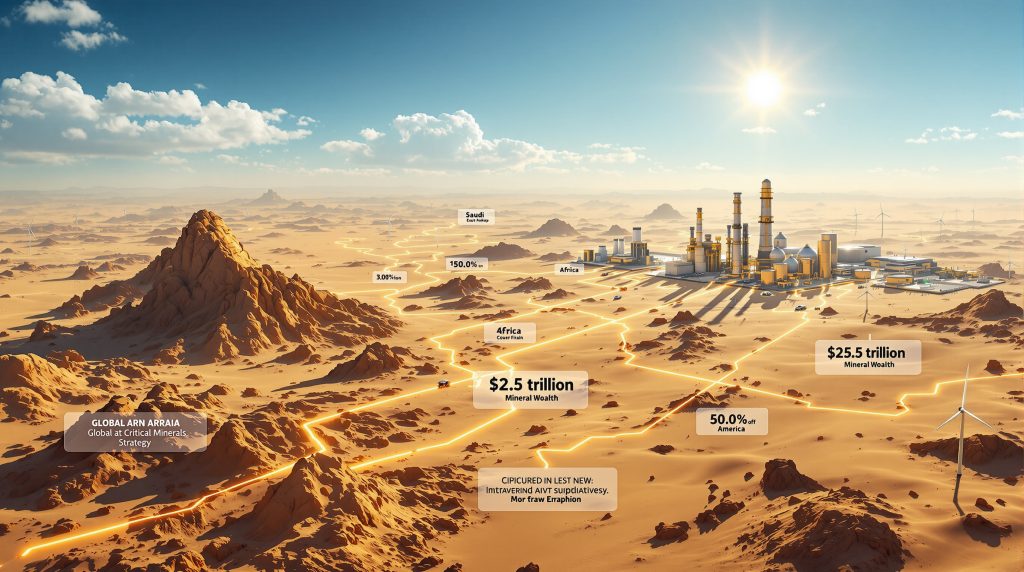The Saudi Arabia critical minerals partnership with the United States represents a pivotal development in global resource strategy. This collaboration, formalised through diplomatic agreements in 2025, positions the Kingdom as a strategic intermediary between Western capital markets and resource-rich developing nations. The partnership addresses critical vulnerabilities in supply chains whilst supporting both nations' industrial diversification objectives.
Furthermore, the bilateral cooperation extends beyond traditional trade relationships. Saudi Arabia seeks economic diversification beyond petroleum dependency, whilst the United States aims to reduce reliance on Chinese dominance in rare earth element processing. This convergence creates unprecedented opportunities for reshaping global mineral supply chains through innovative partnership structures.
Strategic Framework of International Cooperation
The operational framework operates through structured memorandums of understanding across three primary domains: exploration technology sharing, processing infrastructure development, and supply chain security enhancement. These agreements establish clear protocols for technology transfer whilst maintaining strategic autonomy for participating nations.
Bilateral Cooperation Structure
| Component | Saudi Arabia's Role | United States' Role | Strategic Outcome |
|---|---|---|---|
| Exploration Technology | Geological access provision | Advanced mapping systems | Enhanced discovery rates |
| Processing Infrastructure | Refining capacity construction | Technical expertise transfer | Reduced Chinese dependence |
| Supply Chain Security | Geographic stability | Quality control standards | Diversified sourcing networks |
The framework addresses divergent but complementary objectives between Washington and Riyadh. Technology transfer mechanisms require careful navigation of regulatory differences and export controls between partner nations. Joint investment vehicles create pathways for sustainable cooperation whilst preserving strategic autonomy.
However, critical implementation details remain under development. Investment vehicle structures, permitting processes, and operational procedures require further specification. The Saudi exploration licenses system provides a foundation for expanded international cooperation.
Target Materials for Strategic Development
Saudi Arabia's mineral development strategy focuses on materials essential for renewable energy technologies and advanced manufacturing applications. The Kingdom's geological assessments identify significant potential across multiple critical mineral categories that support global energy transition minerals requirements.
Rare Earth Elements Focus
Light and heavy rare earth elements form the cornerstone of development plans. These materials prove essential for wind turbine manufacturing, electric vehicle motor production, and energy storage systems supporting grid modernisation efforts worldwide.
Strategic Metal Reserves
Beyond rare earth elements, the Kingdom's mineral wealth encompasses lithium, cobalt, and graphite. These materials support battery manufacturing and energy storage technologies critical for renewable energy integration and transportation electrification programmes.
The approach extends beyond domestic reserves through partnerships with resource-rich nations. Saudi investments create triangular trade relationships connecting Namibian uranium operations, Guinean bauxite resources, and Democratic Republic of Congo cobalt deposits through Middle Eastern processing infrastructure.
Technical capacity building represents a fundamental requirement for success. Environmental standards harmonisation, labour regulation alignment, and export control coordination create complexity requiring ongoing diplomatic coordination between participating nations.
Why Is the Future Minerals Forum Critical for Global Partnerships?
The Future Minerals Forum scheduled for January 2026 serves as Saudi Arabia's primary vehicle for attracting international investment and demonstrating technological capabilities. This annual diplomatic platform draws policymakers, investors, and mining technologists from diverse geographic regions.
The forum's annual rhythm has evolved into a stage for emerging alliances outside traditional Western mining ecosystems. Saudi Arabia positions itself as a neutral convener in an increasingly polarised resource environment, creating opportunities for multilateral cooperation that transcend traditional geopolitical boundaries.
Neutral Convener Strategy
By maintaining neutrality among competing global powers, Saudi Arabia attracts participation from non-aligned nations who might resist purely Western-led critical minerals initiatives. This approach aligns with broader Middle Eastern diplomatic positioning on resource governance and international cooperation.
The forum creates visibility for Saudi Arabia's hub model connecting U.S. capital to African, Asian, and Middle Eastern mineral deposits. If successfully executed, this strategy could facilitate extraordinary geopolitical reshuffling in global resource relationships.
Previous forums have established precedents for concrete partnership agreements and technology transfer arrangements. The forum provides legitimacy through international participation whilst offering visibility for emerging bilateral and multilateral arrangements. The global resources expo format demonstrates industry interest in diversified partnership models.
Investment Opportunities and Market Dynamics
Global investors increasingly recognise vulnerabilities created by over-reliance on single-source critical mineral suppliers. The Saudi Arabia critical minerals partnership offers portfolio diversification opportunities for resource-focused investment strategies seeking geographic risk distribution.
Supply Chain Diversification Benefits
Investment strategies targeting supply chain resilience benefit from geographic diversification across multiple processing centres. Regional processing hubs reduce transportation costs whilst improving overall supply chain stability against geopolitical disruptions and market volatility.
Infrastructure Development Timeline
Key Investment Milestones:
• Q1 2026: Future Minerals Forum partnership announcements
• 2026-2027: Initial processing facility construction phases
• 2028-2030: Commercial production capacity targets
• 2030+: Full supply chain integration across partner nations
However, investment analysts emphasise caution regarding immediate commercial certainty. Industrial execution requirements include refining capacity development, environmental and social governance credibility establishment, and transparent governance framework implementation across all participating jurisdictions.
Risk Assessment Framework
Until concrete implementation materialises through permits, investment vehicles, and technology transfers, investors should view current developments as geopolitical signals rather than immediate commercial opportunities. Missing elements include industrial execution capabilities, established refining capacity, and proven governance structures.
Market psychology reflects growing awareness of supply chain concentration risks. Chinese dominance in rare earth element refining and magnet manufacturing creates strategic vulnerabilities that alternative processing centres could address through diversified sourcing strategies and innovative partnership models.
Regional Benefits and Strategic Partnerships
The hub strategy creates opportunities for multiple nations across three continental regions through triangular trade relationships and shared infrastructure development programmes. This approach maximises regional economic benefits whilst distributing investment risks.
African Resource Partnerships
African nations benefit from Saudi investment in resource extraction and processing infrastructure. Key partnerships demonstrate the model's potential:
• Namibia: Uranium sector development and processing technology advancement
• Guinea: Bauxite resource extraction and value-added processing capabilities
• Democratic Republic of Congo: Cobalt mining and supply chain integration
These partnerships create employment opportunities whilst developing in-country technical capabilities through structured technology transfer arrangements and capacity building programmes.
Asian Manufacturing Integration
Asian technology partnerships demonstrate how Middle Eastern mineral resources support manufacturing excellence across the region through coordinated supply chain development:
• South Korea: Battery manufacturing supply chain integration
• Japan: Electronics component production support
• Regional Integration: Coordinated supply chains serving multiple manufacturing centres
Saudi Arabia's central location between Europe, Asia, and Africa provides logistical advantages for serving multiple markets through consolidated processing facilities. This geographic positioning reduces transportation costs whilst improving delivery flexibility for diverse customer requirements.
How Does This Compare to Chinese Critical Minerals Strategy?
The Saudi Arabia critical minerals partnership differs fundamentally from China's established dominance in critical minerals processing and supply chain control through decades of systematic infrastructure investment.
Processing Dominance vs. Resource Control
China maintains processing superiority through sustained investment in refining infrastructure and technical expertise development. Saudi Arabia's strategy focuses on controlling upstream resources whilst building processing capabilities through international partnerships rather than purely domestic development.
Partnership Philosophy Differences
| Approach Element | Chinese Model | Saudi Model | Strategic Impact |
|---|---|---|---|
| Development Focus | Processing efficiency | Resource access coordination | Market positioning |
| Partnership Style | Bilateral agreements | Multilateral forum engagement | Diplomatic flexibility |
| Technology Sharing | Controlled access | Open collaboration frameworks | Innovation diffusion |
| Geographic Strategy | Supply chain integration | Hub-based aggregation | Risk distribution |
China's multi-decade investment in processing infrastructure creates substantial competitive advantages through established supply relationships and proven operational capabilities. Saudi Arabia enters during a period when diversification concerns create opportunities for alternative suppliers seeking strategic partnerships.
The Saudi approach emphasises multilateral cooperation and neutral convening rather than direct competition with Chinese capabilities. This strategy aims to complement rather than replace existing supply chains whilst offering diversification options for strategic materials procurement.
Competitive Positioning Analysis
Saudi Arabia's competitive advantages include geographic proximity to multiple markets, substantial financial resources for infrastructure investment, and diplomatic relationships spanning diverse political alignments. However, technical expertise development and operational experience require sustained investment and time.
According to recent analysis, Saudi Arabia's diversification strategy extends beyond traditional petroleum exports to encompass strategic mineral development as a cornerstone of economic transformation.
Vision 2030 Integration and Economic Transformation
The Kingdom's Vision 2030 economic transformation programme positions critical minerals development as essential for achieving long-term diversification objectives beyond petroleum dependency through sustainable industrial development.
Economic Diversification Mandate
The reform agenda requires new revenue streams that align with global energy transition trends. Critical minerals processing creates opportunities for value-added industrial development supporting broader economic transformation goals and fiscal sustainability objectives.
Mining and processing operations generate high-skilled employment opportunities that support workforce development objectives outlined in Vision 2030. These positions require technical training and educational programmes that advance human capital development priorities across multiple industrial sectors.
Industrial Sector Development
Critical minerals processing supports downstream manufacturing capabilities in renewable energy equipment, electric vehicle components, and advanced electronics. These industrial sectors align with Vision 2030's emphasis on technology-intensive economic activities that create sustainable competitive advantages.
Mega-projects like NEOM create demand for critical minerals used in sustainable infrastructure, smart city technologies, and renewable energy systems. Domestic processing capabilities could support these developments whilst reducing import dependencies and improving supply chain security.
The lithium industry innovations demonstrate technological advancement patterns that Saudi Arabia seeks to replicate through international partnerships and technology transfer programmes.
What Challenges Could Limit Partnership Success?
Multiple structural challenges could constrain the effectiveness of the Saudi Arabia critical minerals partnership strategy despite diplomatic momentum and strategic alignment between participating nations.
Regulatory Harmonisation Requirements
Different environmental standards, labour regulations, and export controls between partner nations create operational complexity requiring sustained diplomatic coordination. Mining operations must satisfy diverse regulatory frameworks whilst maintaining consistent quality and safety standards.
Environmental compliance standards vary significantly between participating countries. Successful implementation requires ongoing alignment across multiple jurisdictions whilst preserving operational efficiency and commercial viability for all stakeholders.
Technical Capacity Building Needs
Establishing world-class refining capabilities demands sustained investment in specialised human capital, advanced processing equipment, and comprehensive quality control systems meeting international certification requirements and customer specifications.
"Industrial execution remains the primary challenge, requiring concrete development of refining capacity, environmental and social governance credibility, and transparent operational frameworks."
Infrastructure Development Constraints
Processing facility construction in desert climates presents unique engineering challenges requiring innovative solutions. Water availability, energy supply stability, and transportation connectivity require careful planning and substantial capital investment programmes.
Long-term mining partnerships require sustained political stability across multiple participating nations. Changes in government policies, regulatory frameworks, or international relationships could disrupt established agreements and investment timelines significantly.
Currency volatility and foreign exchange risks affect project economics across multiple countries with different monetary policies and economic stability levels. These financial risks require sophisticated hedging strategies and flexible contract structures to ensure commercial viability.
Global Supply Chain Evolution Through Strategic Cooperation
Successful implementation might inspire similar arrangements in other regions, creating multiple processing centres that improve supply chain resilience whilst reducing concentration risks in strategic material procurement and distribution networks.
Regional Processing Hub Development
The distributed approach offers alternatives to centralised processing models that currently dominate global critical minerals supply chains. This geographic diversification reduces systemic risks whilst improving economic efficiency through optimised transportation and logistics networks.
Saudi Arabia's commitment to international quality standards helps establish benchmarks that benefit global manufacturers requiring consistent material specifications. Standardisation reduces technical risks whilst improving supply predictability for downstream applications across multiple industries.
Technology Transfer Acceleration
Open collaboration frameworks facilitate faster technology diffusion compared to proprietary development models currently prevalent in the industry. This acceleration benefits global innovation in processing techniques and environmental performance improvements that support sustainable development objectives.
Hub-based aggregation creates opportunities for smaller producers to access global markets through shared infrastructure and marketing capabilities. This integration supports market diversity whilst reducing barriers to entry for emerging suppliers seeking international partnerships.
The U.S. Department of Energy's analysis highlights the strategic importance of diversified supply chains for national security and economic resilience.
Investment Monitoring and Progress Assessment Framework
Investors tracking the partnership should focus on concrete implementation signals rather than diplomatic announcements alone to assess commercial viability and investment opportunities accurately.
Concrete Implementation Indicators
• Facility Construction Announcements: Ground-breaking ceremonies and construction contract awards
• Technology Transfer Agreements: Specific partnerships with equipment manufacturers and technical service providers
• Joint Venture Formations: Equity partnerships with defined ownership structures and operational responsibilities
• Export Licence Approvals: Regulatory permissions for international trade in processed materials
Risk Assessment Framework
• Regulatory Stability: Consistency in mining laws and environmental regulations across partner nations
• Environmental Compliance: Achievement of international certification standards for processing operations
• Geopolitical Relationship Stability: Sustained diplomatic cooperation between participating governments
• Market Demand Fluctuations: Price stability and demand growth for target critical minerals
Financial Performance Metrics
Successful partnerships require measurable progress in processing capacity development, production volume targets, and market share achievement in targeted geographic regions. Revenue generation from processing operations provides concrete validation of commercial viability and investment returns.
Technical capabilities must demonstrate consistent quality standards, production efficiency, and environmental compliance that meet international requirements. These operational achievements validate the partnership's industrial execution capabilities and long-term sustainability prospects.
"Current developments represent geopolitical signalling rather than immediate commercial certainty. Industrial execution through proven refining capacity and transparent governance frameworks remains essential for commercial validation."
Long-term Partnership Sustainability
Sustained success requires continued political support, consistent regulatory frameworks, and competitive operational performance across all participating nations. These factors determine whether diplomatic agreements translate into durable commercial relationships that generate sustainable returns for stakeholders.
The framework demonstrates how resource-rich nations can leverage international cooperation to accelerate development whilst maintaining strategic autonomy. This model addresses both security concerns and commercial objectives through structured diplomatic and technical collaboration that benefits multiple stakeholders.
Note: This analysis incorporates information available through November 2025. Readers should verify current developments through official government sources and industry publications, as partnership implementation details continue evolving through ongoing diplomatic and commercial negotiations.
Could Critical Minerals Partnerships Reshape Your Investment Portfolio?
Discover how the Saudi Arabia critical minerals partnership and similar global developments could create new opportunities in your portfolio by exploring Discovery Alert's comprehensive analysis of strategic mineral discoveries. Powered by the proprietary Discovery IQ model, Discovery Alert provides instant alerts when significant ASX mineral discoveries are announced, helping investors identify actionable opportunities in an increasingly complex global resources landscape.




